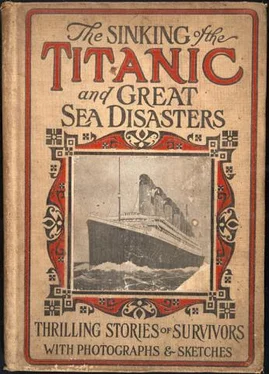Logan Marshall - Sinking of the Titanic and Great Sea Disasters
Здесь есть возможность читать онлайн «Logan Marshall - Sinking of the Titanic and Great Sea Disasters» весь текст электронной книги совершенно бесплатно (целиком полную версию без сокращений). В некоторых случаях можно слушать аудио, скачать через торрент в формате fb2 и присутствует краткое содержание. Год выпуска: 1912, Жанр: Прочая документальная литература, на английском языке. Описание произведения, (предисловие) а так же отзывы посетителей доступны на портале библиотеки ЛибКат.
- Название:Sinking of the Titanic and Great Sea Disasters
- Автор:
- Жанр:
- Год:1912
- ISBN:нет данных
- Рейтинг книги:4.5 / 5. Голосов: 2
-
Избранное:Добавить в избранное
- Отзывы:
-
Ваша оценка:
- 100
- 1
- 2
- 3
- 4
- 5
Sinking of the Titanic and Great Sea Disasters: краткое содержание, описание и аннотация
Предлагаем к чтению аннотацию, описание, краткое содержание или предисловие (зависит от того, что написал сам автор книги «Sinking of the Titanic and Great Sea Disasters»). Если вы не нашли необходимую информацию о книге — напишите в комментариях, мы постараемся отыскать её.
’s demise!
Sinking of the Titanic and Great Sea Disasters — читать онлайн бесплатно полную книгу (весь текст) целиком
Ниже представлен текст книги, разбитый по страницам. Система сохранения места последней прочитанной страницы, позволяет с удобством читать онлайн бесплатно книгу «Sinking of the Titanic and Great Sea Disasters», без необходимости каждый раз заново искать на чём Вы остановились. Поставьте закладку, и сможете в любой момент перейти на страницу, на которой закончили чтение.
Интервал:
Закладка:
Ismay was asked to give more particulars about his departure from the ship. He said:
“The boat was ready to be lowered away and the officer called out if there were any more women or children to go or any more passengers on deck, but there was none, and I got on board.”
Captain Rostron, of the Carpathia, followed Mr. Ismay. He said the first message received from the Titanic was that she was in immediate danger. “I gave the order to turn the ship around as soon as the Titanic had given her position. I set a course to pick up the Titanic, which was fifty-eight miles west of my position. I sent for the chief engineer, told him to put on another watch of stokers and make all speed for the Titanic. I told the first officer to stop all deck work, get out the life-boats and be ready for any emergency. The chief steward and doctors of the Carpathia I called to my office and instructed as to their duties. The English doctor was assigned to the first class dining room, the Italian doctor to the second class dining room, the Hungarian doctor to the third class dining room. They were instructed to be ready with all supplies necessary for any emergency.”
{illust. caption = DIAGRAM SHOWING THE PROXIMITY OF OTHER STEAMSHIPS TO THE TITANIC ON NIGHT OF DISASTER.}
The captain told in detail of the arrangements made to prepare the life-boats and the ship for the receipt of the survivors.
Then with tears filling his eyes, Captain Rostron said he called the purser. “I told him,” said Captain Rostron, “I wanted to hold a service of prayer—thanksgiving for the living and a funeral service for the dead. I went to Mr. Ismay. He told me to take full charge. An Episcopal clergyman was found among the passengers and he conducted the services.”
Captain Rostron said that the Carpathia had twenty lifeboats of her own, in accordance with the British regulations.
“Wouldn’t that indicate that the regulations are out of date, your ship being much smaller than the Titanic, which also carried twenty life-boats?” Senator Smith asked.
“No. The Titanic was supposed to be a life-boat herself.”
Why so few messages came from the Carpathia was gone into. Captain Rostron declared the first messages, all substantially the same, were sent to the White Star Line, the Cunard Line and the Associated Press. Then the first and second cabin passenger lists were sent, when the wireless failed.
Senator Smith said some complaint had been heard that the Carpathia had not answered President Taft’s inquiry for Major Butt. Captain Rostron declared a reply was sent, “Not on board.”
Captain Rostron declared he issued orders for no messages to be sent except upon orders from him, and for official business to go first, then private messages from the Titanic survivors in order of filing.
Absolutely no censorship was exercised, he said. The wire-less continued working all the way in, the Marconi operator being constantly at the key.
Guglielmo Marconi, the wireless inventor, was the next witness.
Marconi said he was chairman of the British Marconi Company. Under instructions of the company, he said, operators must take their orders from the captain of the ship on which they are employed.
“Do the regulations prescribe whether one or two operators should be aboard the ocean vessels?”
“Yes, on ships like the late Titanic and Olympic two are carried,” said Marconi. “The Carpathia, a smaller boat, carries one. The Carpathia’s wireless apparatus is a short-distance equipment.”
“Do you consider that the Titanic was equipped with the latest improved wireless apparatus?”
“Yes; I should say that it had the very best.”
“Did you hear the captain of the Carpathia say, in his testimony, that they caught this distress message from the Titanic almost providentally?” asked Senator Smith.
“Yes, I did. It was absolutely providential.”
“Is there any signal for the operator if he is not at his post?’{’}
“I think there is none,” said Marconi.
“Ought it not be incumbent upon ships to have an operator always at the key?”
“Yes; but ship-owners don’t like to carry two operators when they can get along with one. The smaller boat owners do not like the expense of two operators.”
Charles Herbert Lightoller, second officer of the Titanic, followed Marconi on the stand. Mr. Lightoller said he understood the maximum speed of the Titanic, as shown by its trial tests, to have been twenty-two and a half to twenty-three knots. Senator Smith asked if the rule requiring life-saving apparatus to be in each room for each passenger was complied with.
“Everything was complete,” said Lightoller. “Sixteen life-boats, of which four were collapsible, were on the Titanic,” he added. During the tests, he said, Captain Clark, of the British Board of Trade, was aboard the Titanic to inspect its life-saving equipment.
“How thorough are these captains of the Board of Trade in inspecting ships?” asked Senator Smith.
“Captain Clark is so thorough that we called him a nuisance.”
After testifying to the circumstances under which the life-boats were filled and lowered, Lightoller continued. “The boat’s deck was only ten feet from the water when I lowered the sixth boat. When we lowered the first, the distance to the water was seventy feet.”
“If the same course was pursued on the starboard side as you pursued on the port, in filling boats, how do you account for so many members of the crew being saved?” asked Chairman Smith.
“I have inquired especially and have found that for every six persons picked up, five were either firemen or stewards.”
Thomas Cottam, of Liverpool, the Marconi operator on the Carpathia, was the next witness.
Cottam said that he was about ready to retire Sunday night, having partially removed his clothes, and was waiting for a reply to a message to the Parisian when he heard Cape Cod trying to call the Titanic. Cottam called the Titanic operator to inform him of the fact, and received the reply. ‘Come at once; this is a distress message. C. Q. D.’ “
“What did you do then?”
“I confirmed the distress message by asking the Titanic if I should report the distress message to the captain of the Carpathia.”
“How much time elapsed after you received the Titanic’s distress message before you reported it to Captain Rostron?”
“About a couple of minutes,” Cottam answered.
When the committee resumed the investigation on April 20th, Cottam was recalled to the stand.
Senator Smith asked the witness if he had received any messages from the time the Carpathia left the scene of the disaster until it reached New York. The purpose of this question was to discover whether any official had sought to keep back the news of the disaster.
“No, sir,” answered Cottam. “I reported the entire matter myself to the steamship Baltic at 10.30 o’clock Monday morning. I told her we had been to the wreck and had picked up as many of the passengers as we could.”
Cottam denied that he had sent any message that all passengers had been saved, or anything on which such a report could be based.
Cottam said he was at work Monday and until Wednesday. He repeated his testimony of the previous day and said he had been without sleep throughout Sunday, Monday, Tuesday and until late Wednesday afternoon when he had been relieved by Bride.
Читать дальшеИнтервал:
Закладка:
Похожие книги на «Sinking of the Titanic and Great Sea Disasters»
Представляем Вашему вниманию похожие книги на «Sinking of the Titanic and Great Sea Disasters» списком для выбора. Мы отобрали схожую по названию и смыслу литературу в надежде предоставить читателям больше вариантов отыскать новые, интересные, ещё непрочитанные произведения.
Обсуждение, отзывы о книге «Sinking of the Titanic and Great Sea Disasters» и просто собственные мнения читателей. Оставьте ваши комментарии, напишите, что Вы думаете о произведении, его смысле или главных героях. Укажите что конкретно понравилось, а что нет, и почему Вы так считаете.












